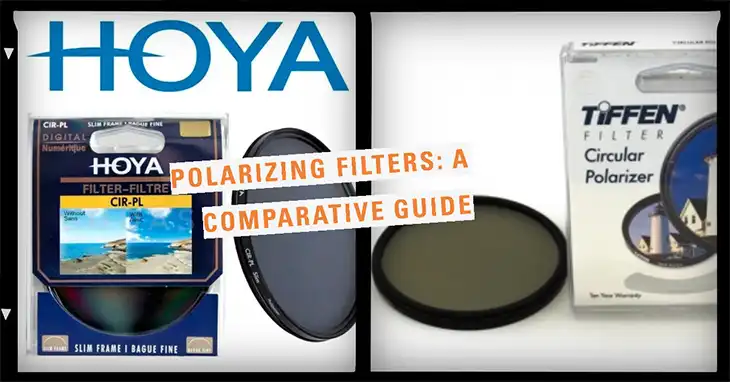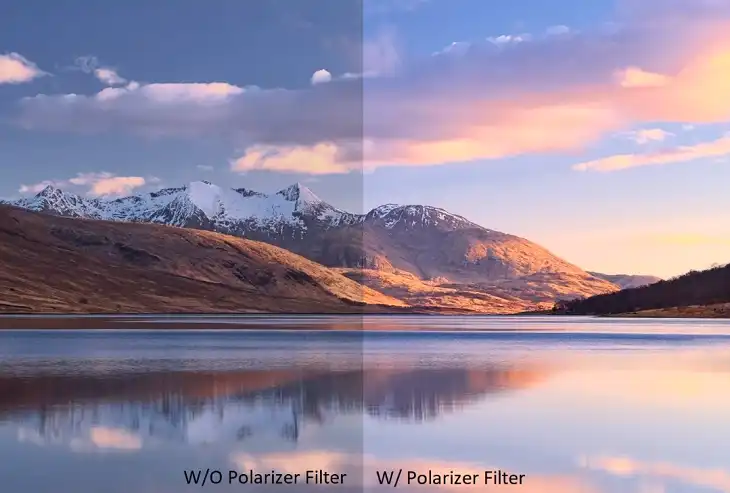As a photographer, you’ve likely experienced the frustration of dealing with unwanted glare, reflections, and a lack of contrast in your images. This is where polarizing filters come into play, serving as a powerful tool to enhance your photographs. Among the countless options available, two brands stand out as industry leaders: Hoya and Tiffen.
In this comprehensive article, we’ll dive deep into the world of circular polarizing filters (CPLs) from these renowned manufacturers, helping you make an informed decision for your next filter purchase.

What’s a Polarizing Filter
Before we delve into the specifics of Hoya and Tiffen, let’s first understand what polarizing filters are and how they work. Polarizing filters are designed to reduce reflections and glare by blocking certain angles of light waves. This results in images with richer colors, deeper saturation, and improved contrast, particularly in situations involving water, glass, or other reflective surfaces.

There are two main types of polarizing filters: linear and circular. While linear polarizers are suitable for most photography needs, circular polarizers (CPLs) are essential for cameras with autofocus and auto-exposure systems, as they prevent potential issues with metering and focusing.
Hoya vs Tiffen Polarizing Filters: Core Functionality Comparison
When it comes to the core functionality of Hoya and Tiffen CPLs, there are a few key areas to consider:
- Light Reduction Capabilities: Both brands are effective in reducing glare and reflections, but they may differ slightly in their ability to do so. User reviews suggest that Tiffen filters may have a slight edge in this department, although the difference is often negligible.
Here’s a comparison table for the filter factor (the amount of light reduction) of some popular models:
| Filter Model | Filter Factor |
| Hoya 67mm NXT Plus | 1.5x (0.6-Stop) |
| Tiffen 67mm Circular Polarizing | 2.3x (1.2-Stop) |
| Hoya 77mm HRT Circular Polarizer UV | 1.5x (0.6-Stop) to 3x (1.6-Stop) |
| Hoya 77mm alpha Circular Polarizer | 3x (1.6-Stop) |
- Image Quality Impact: Both Hoya and Tiffen are known for producing high-quality filters that generally preserve sharpness and minimize color casts. However, some users have reported slight color shifts or vignetting with certain models, particularly when using wide-angle lenses. It’s essential to read reviews specific to the filter model you’re considering to ensure it meets your image quality standards.
- Ease of Use: Most photographers agree that both brands offer relatively user-friendly experiences when it comes to attaching, rotating, and removing the filters. However, some models may have smoother rotation mechanisms or more robust threading, which can make a difference in terms of convenience and longevity.
Hoya vs Tiffen Polarizing Filters: Advanced Features
While the core functionality is crucial, Hoya and Tiffen also offer advanced features that can further enhance your photography experience.
- Multi-Coating Technology: Both brands employ multi-coating techniques to improve the performance of their filters. These coatings not only reduce reflections and ghosting but also provide added protection against scratches, water, and other environmental factors. However, the specific coatings used may vary between models and brands, so it’s worth researching the details of each filter you’re considering.
- Neutral Density (ND) Combination: Some Hoya and Tiffen models offer combined CPL and ND filtering capabilities, allowing you to control exposure while still benefiting from polarization effects. This can be particularly useful in bright conditions or when shooting long exposures, providing greater creative control over your images.
Hoya vs Tiffen Polarizing Filters: Build Quality and Durability
The quality of construction and materials used can significantly impact the longevity and performance of your polarizing filter. Here’s how Hoya and Tiffen stack up:
- Glass/Material Types: Both brands typically use high-quality optical glass in their filters, ensuring exceptional clarity and durability. However, the specific glass types may vary, with some models offering superior scratch resistance or better performance in extreme temperatures.
- Frame Construction: While both brands offer filters with metal and plastic frames, Tiffen is generally regarded as having more robust and durable metal constructions. Hoya, on the other hand, often uses high-quality plastic frames that are lightweight and resistant to cracking or warping.
Hoya vs Tiffen Polarizing Filters: Pricing and Value Proposition
Price is always a consideration when selecting photography gear, and polarizing filters are no exception. Here’s a general comparison of pricing for Hoya and Tiffen CPLs:
| Filter Size | Hoya (Average Price) | Tiffen (Average Price) |
| 52mm | $35 – $60 | $40 – $70 |
| 67mm | $50 – $80 | $60 – $90 |
| 77mm | $60 – $100 | $70 – $120 |
While Tiffen filters generally come with a higher price tag, they also offer a reputation for exceptional build quality and optical performance. Hoya, on the other hand, provides excellent value for money, with filters that deliver impressive results at more affordable prices.
Choosing the Right Filter
Ultimately, the decision between Hoya and Tiffen polarizing filters will depend on your specific needs and priorities. Here are some general recommendations:
For Prioritizing Image Quality
If your primary concern is achieving the highest possible image quality with minimal impact on sharpness, color fidelity, and overall clarity, Tiffen’s higher-end models may be the better choice. However, many users also report excellent image quality from Hoya’s top-tier filters, particularly the HD3 and NXT Plus lines.
For Budget-Conscious Photographers
If you’re working with a limited budget but still want a high-performing polarizing filter, Hoya offers excellent value for money. Their mid-range and entry-level filters often receive praise for their performance-to-cost ratio.
For Specific Needs
If you frequently shoot in challenging environments or require combined ND and CPL filtering capabilities, consider models from both brands that cater to these specific needs. Additionally, if ease of use is a top priority, pay close attention to user reviews regarding rotation mechanisms and threading.
Summary
In summary, both Hoya and Tiffen offer excellent circular polarizing filter options for photographers. While Tiffen is often regarded as the premium choice for build quality and optical performance, Hoya provides outstanding value with filters that deliver impressive results at more accessible price points.
Ultimately, your decision should be guided by your specific needs, priorities, and budget considerations. Whether you prioritize image quality above all else, seek a balance between performance and cost, or have unique requirements like combined ND filtering capabilities, there’s a polarizing filter option from either Hoya or Tiffen that can meet your needs.
Frequently Asked Questions
Can I stack a circular polarizing filter with other filters?
Yes, it’s generally safe to stack a circular polarizing filter with other filters like UV filters or neutral density filters. However, be cautious about potential vignetting or optical degradation, especially when using wide-angle lenses or stacking multiple filters.
Will a polarizing filter affect my camera’s autofocus and metering?
Linear polarizing filters can indeed interfere with your camera’s autofocus and metering systems. That’s why circular polarizers (CPLs) are recommended, as they are designed to work seamlessly with modern camera systems.
How do I determine the correct filter size for my lens?
Check the filter thread size printed on your lens barrel or in the lens specifications. This will typically be a number followed by “mm” (e.g., 77mm). If your filter size doesn’t match the lens thread, you’ll need to use step-up or step-down rings to achieve a proper fit.
Can I use a polarizing filter for video recordings?
Yes, polarizing filters can be used for video recordings to reduce glare, enhance color saturation, and improve overall image quality. However, be mindful of the potential for uneven polarization effects when panning or rotating the camera, as this can cause exposure flickering in your footage.
How often should I clean my polarizing filter?
It’s a good practice to clean your polarizing filter after each use, especially if you’ve been shooting in dusty or humid environments. Use a microfiber cloth and a gentle cleaning solution specifically designed for filters to avoid scratches or damage.
Can polarizing filters help with photographing rainbows?
Yes, polarizing filters can be extremely useful for enhancing the visibility and vibrancy of rainbows. By reducing atmospheric haze and filtering out specific light waves, a polarizing filter can make rainbows appear more vibrant and defined in your photographs.
